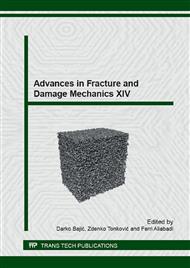p.41
p.45
p.49
p.53
p.57
p.61
p.65
p.69
p.73
Flexural Property and In Situ Observation of Carbon Milled Fiber Added Plain Woven Carbon Fiber/Epoxy Resin Composite
Abstract:
In this study, effect of Carbon Milled Fiber (CMF) addition on flexural fracture property of Carbon Fiber Reinforced Plastics (CFRP) was investigated. The CMF additive amounts to the epoxy resin were 0.5wt%, 0.8wt%, 1.0wt% and 1.2wt%. Static three point flexural test was conducted based on Japanese Industrial Standard (JIS) K 7074. The in situ observation of CMF added CFRP was conducted by using high-speed camera. As a result, following conclusions were obtained. In case that CMF additive amount was below 0.8wt%, flexural strength and flexural modulus of CFRP increased with an increase of CMF additive amount. In case of that CMF additive amount was above 1.0wt%, flexural strength and flexural modulus of the CFRP decreased compared with those of CMF 0.8wt% added CFRP. From in situ observation, crack initiation occurred at external layer on tension side of non CMF and CMF added CFRP. After crack initiation, delaminations of non CMF and CMF added CFRP were found. The delamination size of CMF 0.8wt% added CFRP was smaller than that of non CMF and CMF 1.2wt% added CFRP. Therefore, flexural property of CFRP was improved because delamination of CFRP was prevented by CMF 0.8wt%.
Info:
Periodical:
Pages:
57-60
Citation:
Online since:
September 2015
Authors:
Keywords:
Price:
Сopyright:
© 2016 Trans Tech Publications Ltd. All Rights Reserved
Share:
Citation:


